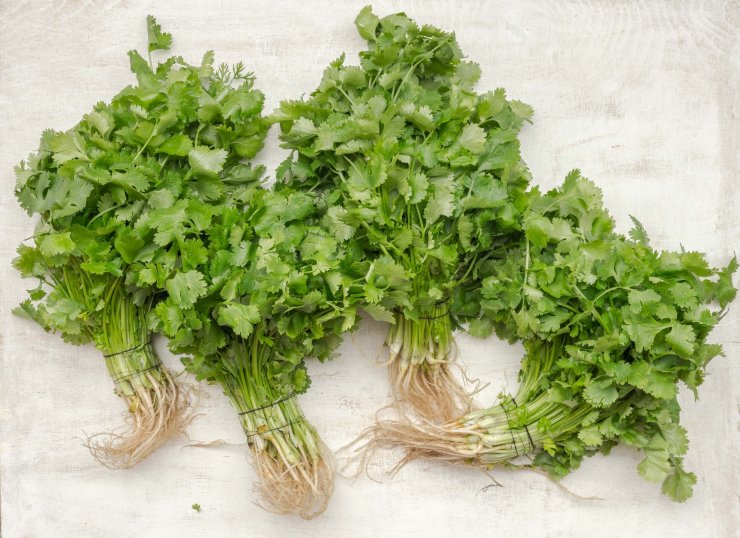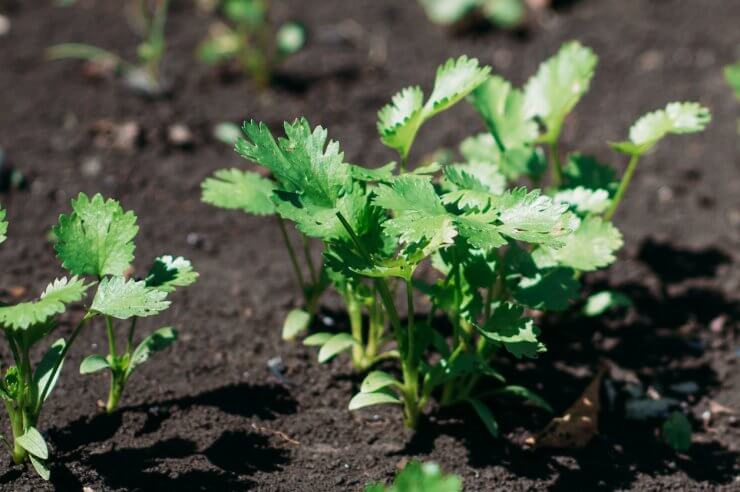When I think of growing cilantro, I think of a fresh bowl of our BLT Guacamole, ready at the helm. If you’re growing tomatoes, onions, and especially avocados, you have a recipe for guacamole right in your backyard. You also have ingredients for salsa verde, tom yum soup, and chicken curry. Cilantro Lime Rice is one of my favorite recipes to make with cilantro!
With notes of lemon-lime, a grassy parsley-like flavor, and just a hint of spice, cilantro has an unmistakable taste. The great news is that if you want to start growing it, cilantro is a pretty easy annual plant to cultivate, and you get a two-for: an herb (the leaves) and a spice (the seeds – known as coriander). In fact, all parts of the cilantro plant are edible, including seeds, leaves, stems, flowers, and roots. The roots have a pronounced flavor prized by cooks—another good reason to grow your own cilantro as grocery stores often remove the roots.

Cilantro also offers quick gratification: you can usually start harvesting stems and leaves 3-4 weeks from planting.
Without further ado, let’s talk about the most interesting things you should know about growing cilantro, but if you keep in mind that with a mix of sunshine, shade, and not too much water, you’ll be well on your way to fresh cilantro for salads, main dishes, dips, and more!

10 Fun Facts About Growing Cilantro
1. Cilantro grows best in Zones 2-11. Cilantro thrives when planted in the ground in USDA Plant Hardiness Zones 2 to 11; they do quite well as container plants, too—just bring them in before temperatures drop and make sure you place them in a warm, sunny, draft-free spot for the winter. Because cilantro grows so quickly, most gardeners sow seeds directly into the soil soon after the last frost in the spring. Plant the seeds about 2 inches apart about a 1/4 inch under the soil. Space rows 12 inches apart. Keep the soil moist until the seeds sprout at least 2 leaves, then thin to 6 inches apart.
2. Cilantro is considered an annual plant, meaning it grows for one year and dies, though cilantro often reseeds itself. So, plant it in a location where there is room for dropped seeds to sprout the next year.
3. You can easily grow cilantro from seeds, seedlings, or cuttings, indoors or out, but no matter how you plant it, cilantro has a relatively brief lifecycle. It sprouts quickly in the cooler months, is ready to harvest in as little as 30 days, then bolts and flowers under the hot summer sun, then you’re left with the seeds as it dries out—coriander. If leaf production and harvest are your goals, sow cilantro successively over three to four weeks and make sure your plants get some afternoon shade to slow bolting.
4. If you get seeds from a friend, they may still be in their husk, gently crush the husk to release the seeds—two in each husk. Soak the seeds for 24-48 hours and dry them before planting.
5. If you already have cilantro and you’d like to have more, you can take a cutting from a healthy plant. Trim about a seven-inch section of the branch that has at least three inches of stem. Remove any bottom leaves, leaving about three leaves at the top. Place the cuttings in a clean glass of water. Roots will form quickly, and you can transplant to the garden or a container in 2 to 3 weeks.
6. Cilantro loves sunshine and loamy, well-draining soil, but cilantro is delicate and also needs part shade, especially in the afternoon sun. Cilantro does best in soil that has a pH between 6.2 and 6.8. As long as the soil drains well, cilantro plants seem to be fairly adaptable.
7. Many gardeners like to plant cilantro among other plants, such as tomatoes and spinach, where cilantro’s flowers can attract beneficial insects.
8. Cilantro does not need pruning per se, but you will encourage bushier plants if you pinch or snip off some of the top leaves from the main stem as soon as they appear to be developing flowers or seedpods. This will direct plant energy back into leaf production.
9. Cilantro likes a long drink of water once in a while. How long a while is, depends on your environment and your soil. Cilantro likes soil that’s moist, but not soggy. In general, you’ll want to water deeply about once a week; again, it depends on your specific environment. If the top of the soil is a little dry, that’s OK. But don’t let the soil dry out.
10. Fast-growing cilantro, with its relatively short lifecycle, does not need much – if any – fertilizer. If you have prepared your soil well with organic matter, you won’t need to fertilize your cilantro often. A little liquid nitrogen fertilizer applied when the plants are about 2 inches high might be enough.
Bonus fun fact: The reason why 25% of the population think cilantro tastes like dish soap is because it’s linked to a gene that interprets the flavor differently from most people. I sure feel sorry for those folks!
Want to grow cilantro at home?
Cilantro, or coriander, brings a distinctive flavor to many favorite ethnic cuisines including Mexican, Thai, and Indian. But you don’t have to cross the border to have fresh cilantro—you can grow it in your garden or even indoors and enjoy this tasty herb year-round. With this gardening guide, you get all the details that go into growing and harvesting flavorful cilantro and its seed form, coriander. Get recipes for a fiesta of sweet and savory dishes that make it all the more rewarding to grow your own cilantro. Get it all in our Celebrate Cilantro Gardening Guide right now!


 Previous
Previous

